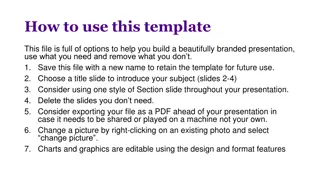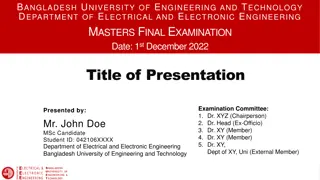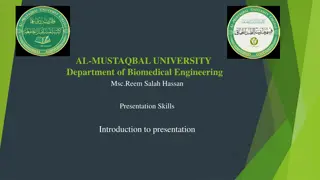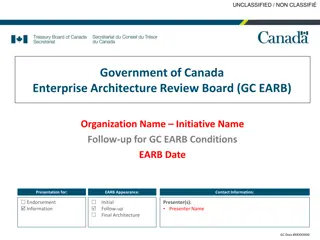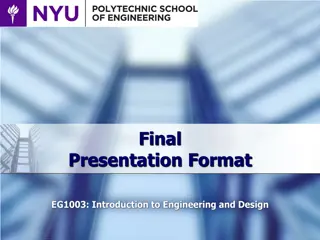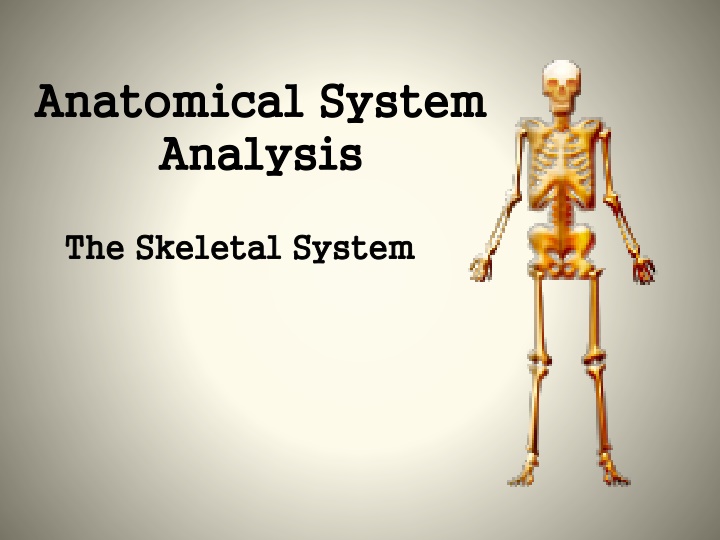
The Importance of the Skeletal System in Archaeological Excavations
Discover the vital role of the skeletal system in archaeological digs, where students identify and piece together skeletal remains to determine funding for excavation projects. Learn about the foundational significance of the skeletal system and its functions in our bodies, essential for movement, blood cell production, and overall health.
Download Presentation

Please find below an Image/Link to download the presentation.
The content on the website is provided AS IS for your information and personal use only. It may not be sold, licensed, or shared on other websites without obtaining consent from the author. If you encounter any issues during the download, it is possible that the publisher has removed the file from their server.
You are allowed to download the files provided on this website for personal or commercial use, subject to the condition that they are used lawfully. All files are the property of their respective owners.
The content on the website is provided AS IS for your information and personal use only. It may not be sold, licensed, or shared on other websites without obtaining consent from the author.
E N D
Presentation Transcript
Anatomical System Anatomical System Analysis Analysis The Skeletal System The Skeletal System
Anatomical System Analysis: Skeletal System The skeletal system is the foundation of our body. Without the skeletal system, the muscles, ligaments, tendons, and tissue would have nothing to attach to. You would not be able to move without the assistance of the skeletal system. The skeletal system also provides the source of blood cells, for both the reproduction of new cells and the cells that fight infection and disease. Knowing about the skeletal system and how it works is essential to the basic knowledge of life.
Anatomical System Analysis: Skeletal System Your group has been asked to the site of an archeological dig in southeast Texas. The students will actually be in the science lab classroom, and only travel to the dig site via a presentation by the archeological dig team. Your group will be given the task of identifying skeletal remains and putting together remains into a full skeleton, if possible. Your group must accurately identify and organize the skeletal remains, because the results of your efforts will determine the continuation of the funding for the archeological excavation project.
Anatomical System Analysis: Skeletal System Introductory Introductory Steps 1. The student group will only be identifying the skeletal remains after they have been excavated from the dig site: no archeology skills will be needed by the group. 2. The group will use a set of photos that portray individual skeletal parts for the identification of the remains. Steps
Anatomical System Analysis: Skeletal System Foundations Foundations Literacy: Literacy: The students will work as a group to determine, using comparative photographs, and the identity of parts of the skeletal system. The students, once identity has been established, will put together a human skeleton based on the identified parts in the possession of each group. The students will use their ability to analyze, compare and contrast, and collaborate to reach a correct solution to the problem.
Anatomical System Analysis: Skeletal System Foundations Foundations Problem Problem- -Solving: Organizing Problem: Organizing Problem: The problem that will anchor this design will be, Can you identify the skeletal remains based on photographic matching to determine type of bone and where it fits into the skeletal system? General Problem Solving Strategies: General Problem Solving Strategies: analyze, compare, contrast, identify selection, collaboration, and the use of deductive reasoning Solving:
Anatomical System Analysis: Skeletal System Foundations Foundations Knowledge Knowledge: : Structures: Structures: Students will need to possess the ability to analyze and compare based on photographic evidence and the real skeletal bone. They must able to use visual evidence to determine bone structure and anatomical differences. Discourse: Discourse: The archeological team will give a presentation on how they identify skeletal remains at a dig site. This will allow students to see a hands-on presentation of how professionals in the field determine the identity of skeletal remains.
Anatomical System Analysis: Skeletal System Foundations Foundations Using Information: Using Information: Community: Community: The group will have different team members whose roles will be determined by the group itself; each student will assume each different role during the lesson. Communication among group members will be essential.
Anatomical System Analysis: Skeletal System Activities Activities Authentic Activities: Authentic Activities: Video Presentation: The archeological dig team will be presenting, via YouTube video, how they work as a group/team to determine the identity of skeletal remains. Background Building Activities: Background Building Activities: Prior to the lab lesson on the identifying of skeletal remains, the students will have experienced several lecture and activity lessons on identifying skeletal remains by using photographs, and other means of identification.
Anatomical System Analysis: Skeletal System Activities Activities Constructing Constructing Activities: After the lesson, activities will be constructed for the students to use their analyzing skills in other human body systems discussions, and lessons. The other body systems can be analyzed similarly using analysis, compare/contrast, inductive/deductive reasoning, and collaboration. The TEKS for Anatomy and Physiology are based on comparative skill building for the systems of the human body. Activities:
Anatomical System Analysis: Skeletal System Contents Contents Contents: Contents: TEKS TEKS: Texas Essential Knowledge and : Texas Essential Knowledge and Skills Skills 121.13. Anatomy and Physiology of Human Systems (One Science Credit). (a), (b)(1,2,3), (c)(1A,1B)(2A,2B,2C,2D)(3A,3B,3C,3D,3E)(10A,10B, 10C,10D)
Anatomical System Analysis: Skeletal System Tools Tools Tools: Tools: The tools to be utilized for this lesson are the internet, photographs of the skeletal system, and YouTube video of the presentation of the archeological team.
Anatomical System Analysis: Skeletal System Systems of Assessment Systems of Assessment Assessments: Assessments: Rubric: Rubric: A rubric will be developed to determine the degree to which the student(s) correctly identified the parts of the skeletal system. The rubric must take into account the level of analysis needed to determine the identity of certain skeletal system structures and the students ability and effort to grade accordingly.
Anatomical System Analysis: Skeletal System Learning Environment Learning Environment Environment: Environment: The learning environment will be a science lab classroom. Each class of 30 students will be divided into groups of 5 students for this lesson. The classroom will also be equipped with a projector and screen, so that the groups of students can watch the presentation by the archeological team.
Anatomical System Analysis: Skeletal System To To Do To Do List: To Do List: Determine the identity of the skeletal remains Assemble a full skeleton, if possible; Are the right types and numbers of bones available? Do


